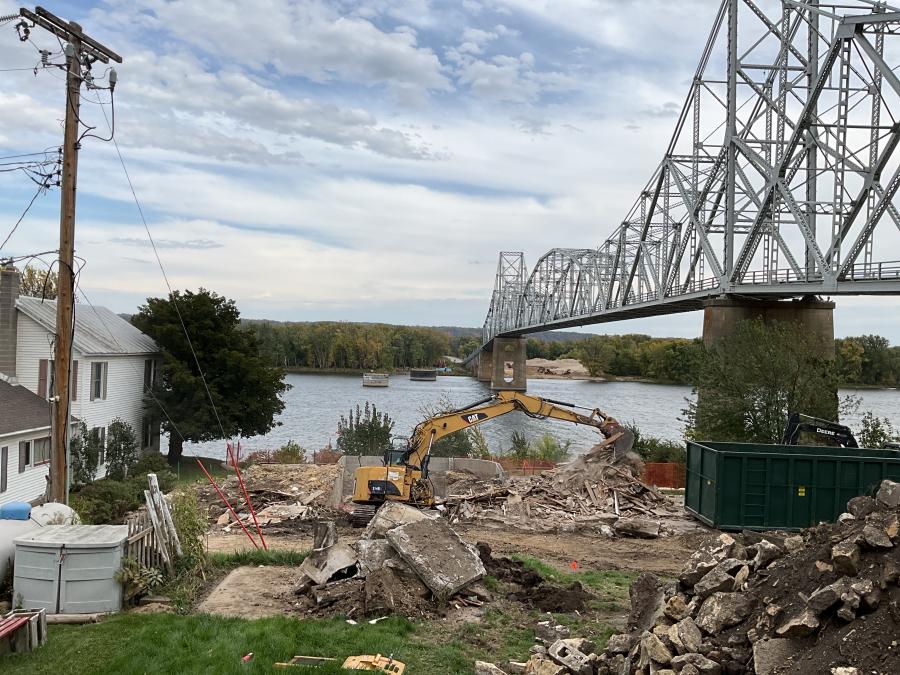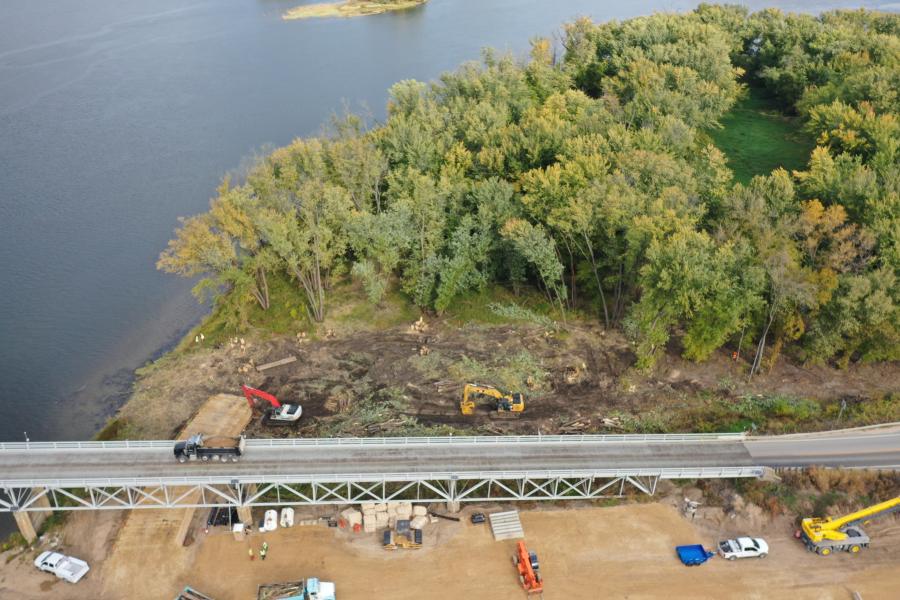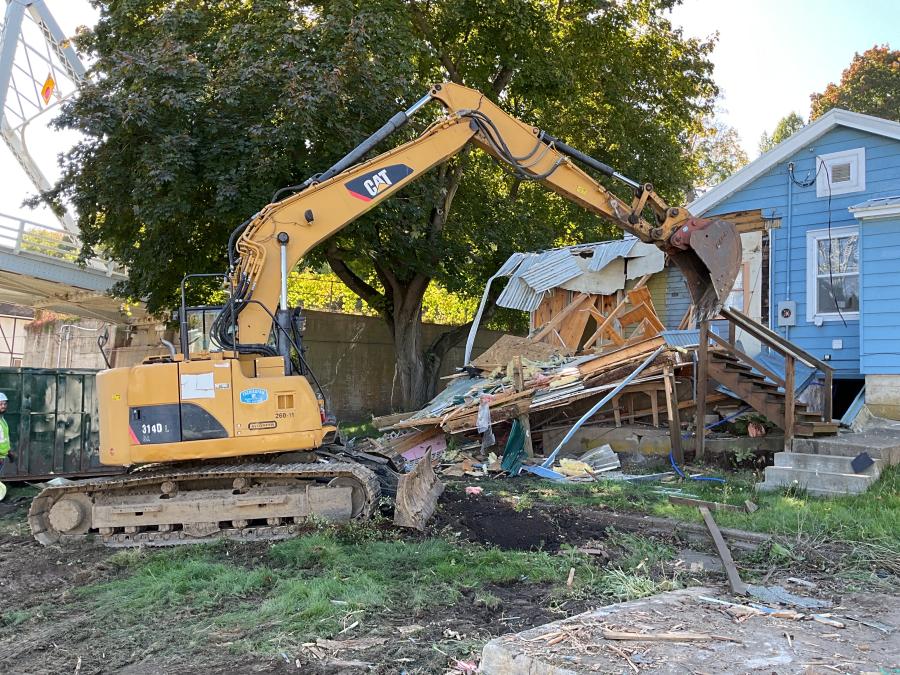Iowa DOT is coordinating with Wisconsin DOT to complete the $124 million Black Hawk Bridge Replacement project.
(Iowa DOT photo)
Close to a century ago, foundation work began on an iconic Midwestern bridge that's served motorists through the decades. Now the structure that's carried drivers across the Mississippi River from Lansing, Iowa, to rural Crawford County, Wisconsin, is facing the wrecking ball.
"The bridge has stood since 1931, and is nearing the end of its life cycle," said Pete Hjelmstad, Iowa Department of Transportation (Iowa DOT) District 2 field services coordinator. "A study was done in 2019 to see if it was possible to rehab the bridge. It showed replacing the bridge was the most cost-effective way to move forward."
Known originally as the Black Hawk Bridge, the structure has a narrow deck at only 21 ft., with no shoulders. This makes it problematic for drivers with mechanical issues to pull over safely. The new bridge will be wider, at 40 ft. (two 12-ft. driving lanes with 8-ft. shoulders on both sides).
"The new deck will be concrete, compared to the current welded steel grate," Hjelmstad explained. "The current deck needs periodic maintenance and can mean shutting down the bridge, or at the least, limiting traffic to one lane with traffic signals on either end of the bridge. The project also includes reconstructing a stretch of Iowa 26 that includes widening the turning radius."
Hjelmstad said the current intersection is very tight and difficult for semis and large trucks to make the turn.
"Besides better serving motorists, the new bridge will better serve barge traffic. Because of the turn the barges have to make and the 650-foot channel width between the current piers, this maneuver is considered one of the most difficult on the Mississippi River, and has resulted in barges coming loose, hitting the piers or the protective dolphins that were installed in 1993 and 2011. The new bridge piers will be 750 feet apart, making things much easier for barge traffic, and will be built to withstand a barge hit."
Iowa DOT is coordinating with Wisconsin DOT to complete the $124 million project.
"This bridge is mutually owned, with Iowa DOT being the lead agency on construction and maintenance," said Hjelmstad. "We are splitting the cost of the bridge replacement project with Wisconsin and have been meeting with them regularly over the past three years during the design process.
"The new bridge will be a steel through-truss bridge. It will be 180 feet tall by 1,352 feet long, compared to the current bridge which is 165 feet tall by 1,152 feet long. The bridges will look nearly identical. Both states, along with the Federal Highway Administration, have agreed to complete several efforts to keep the historic look of the bridge. Those efforts include the replacement of the bridge with a similarly designed bridge, completing additional historic research and developing and producing a mini-documentary film."
Initial construction started in October, with the demolition of two houses in Lansing and the removal of trees in Wisconsin. The new bridge is scheduled to open to traffic in the fall of 2026, followed by demolition of the existing structure, described as one of the most unusual and significant large-scale cantilever truss bridges in the nation.
Hjelmstad said during construction there will be increased traffic in the area because of trucks hauling material to and from the site.
"Vehicle traffic will see the most impacts in 2026, when Iowa 26 is reconstructed. That will limit traffic to one lane in each direction, with temporary traffic signals in place, as well as a lane width of 11 feet. The current bridge will remain open to traffic during construction, except for a two-to-three-week period in late 2026 to tie the new bridge into the existing roads on both the Iowa and Wisconsin sides of the river."
According to Iowa DOT project manager Clayton Burke, working on the Mississippi River is challenging.
"The river's flow and elevation can change significantly for long periods of time during seasonal floods. This uncertainty in the future water level makes it difficult to determine how tall to build temporary work structures like cofferdams.
"Working over the river also means construction will likely be performed from barges. Working from barges adds complexity to getting people, equipment and materials to the work site and safety concerns for those working near the water. Another challenging part of the project is avoiding culturally sensitive areas on the Iowa side of the river."
The contractor, Kraemer North America of Plain, Wis., is currently mobilizing equipment, preparing a stable rock working pad and installing a dock wall for future river access. Burke noted that complex projects require a lot of planning and reviewing before the work actually starts.
"Many of the initial tasks have been creating, submitting and reviewing various construction documents that detail exactly how the contractor plans to build the bridge to the contract specifications. However, there have been a few construction tasks that have been completed, such as clearing trees in the work area, demolishing two residential properties in the new bridge's footprint and digging in a few of the new city water lines that needed to be moved."
Demo involved excavators, skid loaders and dumpsters. After the debris was removed, the contractor filled and leveled the site to match the surrounding area. Cleaning up the site involves picking up a lot of debris to make sure nothing is left behind.
According to Burke, the contractor also fills and levels any holes left behind with soil. For the utilities, the contractor worked with the city and local authorities to remove or terminate the residential utilities appropriately.
Burke said the first key task on the Iowa side of the project will be constructing the drilled shafts for the pier located on the riverbank.
"The contractor will then construct the rest of that pier, build a large retaining wall near Iowa 26, construct the bridge abutment behind that wall, erect the Iowa side of the steel truss, pour the bridge deck and then reconstruct the Iowa 26 and the IA 9 interchange to align with the new bridge."
As for site conditions, said Burke, "Working within the limits of a city and the narrow right-of-way on the Wisconsin side makes for very limited space. The contractor has to plan the order in which they perform the work carefully, or they may have a challenge getting their equipment to the right location.
"Safety is the priority on every project, and the risks added by the river, barges, trains and working near the city have to be carefully planned for and addressed on a daily basis. Any time a person is working below the surrounding surface, there is a risk of collapse. It is important that OSHA regulations are followed to keep everyone safe."
Crews also must be mindful of the elements at all times. Burke explained that chilly winter temperatures and short days will make working from barges on the river even more difficult.
"The contractor will need to use an icebreaker barge to keep the ice open, and the freezing temperatures add to equipment breakdowns and the need for warming shacks to keep people safe. Flooding in the spring and summer could submerge the work site and make the river flow too high to hold barges in place. This could add delays to the schedule."
Roughly 10,000 cu. yds. of dirt and sand will be moved during construction. Heavy equipment being used will include excavators, skid loaders and lifts.
"There are some very large cranes in the 100-to-210-ton range," said Burke. "There also will be a much larger ringer crane over 400 tons located on a barge mobilizing to the site. The 11.5-foot diameter drilled shafts will require a specialty made drill rig operated by crane to dig down 150 feet and drill into the sandstone bedrock."
Despite all the obstacles, Burke considers it an honor to be a part of the high-profile project.
"I think about all the great memories I had as a kid that involved driving across the existing IA 9 Bridge, and I hope the new bridge makes those memories possible for generations to come. It's an opportunity of a lifetime to be a part of a team that's building a structure that will provide safe, reliable travel for the next 100 years." CEG
Today's top stories




















